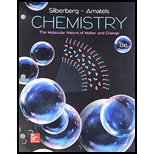
(a)
Interpretation:
The given reaction has to be shown whether it is thermodynamically feasible or not.
Concept introduction:
Free energy (or) entropy change is the term that is used to explain the total energy content in a thermodynamic system that can be converted into work. The free energy is represented by the letter G. All spontaneous process is associated with the decrease of free energy in the system. The equation given below helps us to calculate the change in free energy in a system.
Where,
(a)
Answer to Problem 20.93P
Methanol formation standard free energy values is
Explanation of Solution
The reaction for formation of methanol is,
Standard enthalpy change is,
The enthalpy change for the reaction is calculated as follows,
Hence, the enthalpy changes
Entropy change
Calculate the change in entropy for this reaction as follows,
Where,
The
Calculate the Free enrgy change
Standared Free energy change equation iss,
Calcualted enthalpy and entropy values are
These values are plugging above standard free energy equation,
Methanol formation standard free energy values is
(b)
Interpretation:
The given methanol formation reaction has to be shown that whether it is favored at low or at high temperatures.
Concept introduction:
Any natural process or a
In
(b)
Explanation of Solution
The reaction for formation of methanol is,
Calcualted enthalpy and entropy values are
At temprature become above
(c)
Interpretation:
For the given methanol oxidation reaction the
Concept introduction:
Free energy (or) entropy change is the term that is used to explain the total energy content in a thermodynamic system that can be converted into work. The free energy is represented by the letter G. All spontaneous process is associated with the decrease of free energy in the system. The equation given below helps us to calculate the change in free energy in a system.
Where,
(c)
Answer to Problem 20.93P
Methanol oxidation reaction standard free energy values is
Explanation of Solution
The oxidation reaction of methanol is,
Standard enthalpy change is,
The enthalpy change for the reaction is calculated as follows,
Hence, the enthalpy changes
Entropy change
Calculate the change in entropy for this reaction as follows,
Where,
The
Calculate the Free enrgy change
Standared Free energy change equation is,
Calculated enthalpy and entropy values are
These values are plugging above standard free energy equation,
Therefore, the given oxidation reaction standard free energy values is
Want to see more full solutions like this?
Chapter 20 Solutions
Loose Leaf for Chemistry: The Molecular Nature of Matter and Change
- Polymers may be composed of thousands of monomers. draw two repeat units(dimer) of the polymer formed in this reaction. assume there are hydrogen atoms on the two ends of the dimer. ignore inorganic byproducts pleasearrow_forwardDraw the product of the reaction shown below. Use a dash or wedge bond to indicate stereochemistry of substituents on asymmetric centers, Ignore inorganic byproductsarrow_forwardDraw the product of this reaction please. Ignore inorganic byproductsarrow_forward
- One of the pi molecular orbitals of 1,3-butadiene (CH2=CHCH=CH2) is shown below. Please identify the number of nodal planes perpendicular to the bonding axisarrow_forwardDraw the monomers required to synthesize this condensation polymer please.arrow_forwardProvide the correct systematic name for the compound shown here. Please take into account the keyboard options belowarrow_forward
- curved arrows are used to illustrate the flow of electrons. using the provided starting and product structures, draw the curved electron-pushing arrows for the following reaction or mechanistic step(s)arrow_forwardIdentify the 'cartoon' drawing of the acceptor orbital in the first mechanistic step of an electrophilic addition reaction of butadiene with HBr. Pleasearrow_forwardH- H H H H H H Identify and select all structures below that represent a constitutional isomer(s) of the compound shown above. H- H H H A. H H H H-C CI H H D. H H H H H H C C -H H C C H H H H B. H CI H H- C C H H H H E. H CI H C.arrow_forward
- Why doesn't this carry on to form a ring by deprotonating the alpha carbon and the negatively-charged carbon attacking the C=O?arrow_forward6. A solution (0.0004 M) of Fe(S2CNEt2)3 (see the structural drawing below) in chloroform has absorption bands at: 350 nm (absorbance A = 2.34); 514 nm(absorbance A = 0.0532); Calculate the molar absorptivity values for these bands. Comment on their possible nature (charge transfer transitions or d-d S N- transitions?). (4 points)arrow_forwardWhat is the mechanism for this?arrow_forward
 ChemistryChemistryISBN:9781305957404Author:Steven S. Zumdahl, Susan A. Zumdahl, Donald J. DeCostePublisher:Cengage Learning
ChemistryChemistryISBN:9781305957404Author:Steven S. Zumdahl, Susan A. Zumdahl, Donald J. DeCostePublisher:Cengage Learning ChemistryChemistryISBN:9781259911156Author:Raymond Chang Dr., Jason Overby ProfessorPublisher:McGraw-Hill Education
ChemistryChemistryISBN:9781259911156Author:Raymond Chang Dr., Jason Overby ProfessorPublisher:McGraw-Hill Education Principles of Instrumental AnalysisChemistryISBN:9781305577213Author:Douglas A. Skoog, F. James Holler, Stanley R. CrouchPublisher:Cengage Learning
Principles of Instrumental AnalysisChemistryISBN:9781305577213Author:Douglas A. Skoog, F. James Holler, Stanley R. CrouchPublisher:Cengage Learning Organic ChemistryChemistryISBN:9780078021558Author:Janice Gorzynski Smith Dr.Publisher:McGraw-Hill Education
Organic ChemistryChemistryISBN:9780078021558Author:Janice Gorzynski Smith Dr.Publisher:McGraw-Hill Education Chemistry: Principles and ReactionsChemistryISBN:9781305079373Author:William L. Masterton, Cecile N. HurleyPublisher:Cengage Learning
Chemistry: Principles and ReactionsChemistryISBN:9781305079373Author:William L. Masterton, Cecile N. HurleyPublisher:Cengage Learning Elementary Principles of Chemical Processes, Bind...ChemistryISBN:9781118431221Author:Richard M. Felder, Ronald W. Rousseau, Lisa G. BullardPublisher:WILEY
Elementary Principles of Chemical Processes, Bind...ChemistryISBN:9781118431221Author:Richard M. Felder, Ronald W. Rousseau, Lisa G. BullardPublisher:WILEY





